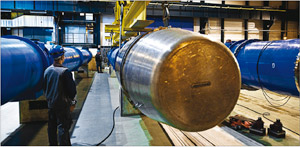In a workshop in Chamonix on 2–6 February, members of the LHC accelerator and experimental teams, as well as CERN’s management, met to formulate a realistic timetable to have the LHC running safely and delivering collisions. The main outcome is that there will be physics data from the LHC in 2009 and there is a strong recommendation to run the machine through the winter until the experiments have produced substantial quantities of data. Such extended running could achieve an integrated luminosity of more than 200 pb–1 at 5 TeV per beam.
Meetings in Chamonix were a feature of the annual winter shutdown at CERN during the LEP era, providing a forum where intense discussions led to a clear consensus on objectives for the following year. CERN’s director-general, Rolf Heuer, intends for similar meetings to guide operations during the LHC era. The first occasion provided a tough start, as the participants had to agree on the best way to proceed following the incident in sector 3-4 that brought LHC commissioning to a halt last September.

The crucial improvement since the incident in sector 3-4 is a new resistance-measurement system which can detect nano-ohm resistances in the joints. This new system would have prevented September’s incident and will prevent all imaginable failures of a superconducting joint in the future. The work on this new detection and protection system was reviewed at the workshop and is already making good progress. Following completion of the design of the two principal electronics boards, the first orders were placed in early February. At the same time, manufacture of the cable segments had begun and installation started in sector 4-5.
For any “unimaginable” failure of a joint, the installation of new pressure-relief valves will reduce the amount of damage that occurs, compared with last year. The new valves will prevent pressure build-up and collateral damage by allowing a greater rate of helium release in the event of a sudden increase in temperature. Discussions in Chamonix centred on whether to install these pressure-relief valves in one go or to stage their installation over the next two shutdowns. There were many interesting exhanges on this topic and opinions were divided. The CERN management is to make the final decision on this in the week beginning 9 February.
Meanwhile, work continues apace on the repairs at the LHC. At the end of January, a dipole from sector 1-2, which had been identified as having an internal splice resistance of 100 nΩ, was opened up after removal from the tunnel and was found to have little solder on the splice joint. It is likely that a similar small resistance was at the root of the incident in sector 3-4. The LHC teams can now detect a single defective splice in situ when a sector is cold and they have identified another dipole showing a similar defect in sector 6-7. This sector will be warmed up and the magnet removed. Each sector has more than 2500 splices, but the resistance tests can only be conducted on cold magnets. Three sectors remain to be tested: sector 3-4, where the incident occurred, and the adjoining sectors, 2-3 and 4-5.
Tests on the magnets were among the important topics under discussions at Chamonix. The participants agreed on teams to work on the detailed analysis of the measurements made during the cold tests of magnets in building SM18 before their installation in the tunnel. New analysis techniques will be devised to provide a complete picture of the resistance in the joints of all magnets installed in the LHC. The aim is to allow an early warning and early correction of any further suspicious splices.
• For up-to-date news, see The Bulletin at http://cdsweb.cern.ch/journal/.







